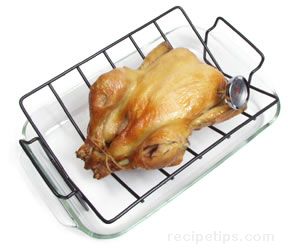|
When choosing a chicken for roasting, it is best to select a bird that is labeled a "roaster." Roasters are generally older birds with more muscle, flavor and fat. The fat is favorable for roasting because it adds flavor and moisture to the meat as it is cooking and will eventually melt off through the cooking process.
Roasting is accomplished by cooking the chicken uncovered in a hot oven. The chicken is cleaned, seasoned, stuffed (optional), and then placed on a rack in a shallow roasting pan. The rack is not necessary, but it will improve the quality by holding the bird out of the juices and allowing the heat to reach evenly around the entire bird, providing a chicken that is golden brown on all sides. It will also allow the juices to evaporate more easily, developing a caramelized layer, which will produce a very flavorful base for making a sauce or gravy.
The chicken should be cooked in at a higher heat, for a short period of time, to crisp the skin and seal in the juices to provide moist, tender meat. Generally roasting at about 450°F for 15 to 20 minutes is adequate.. The heat should then be reduced to 375°F for the rest of the cooking time. Basting the bird throughout the cooking time is not necessary, unless the chicken is smaller, generally under three pounds. The smaller birds do not have the fat necessary to flavor the meat and keep it moist. Cooking temperatures and times will vary according to the size of the chicken and varying recipes.
The length of time a chicken will have to cook depends on whether it is stuffed and/or trussed and on the quantity of other ingredients, such as potatoes and vegetables, added to the pan. The best way to determine if it has cooked long enough is to check for doneness. You do not want to overcook the chicken but if undercooked, it will not be full flavored and will not have the desired texture. It also needs to be cooked to the proper doneness to make it safe to eat. Shown below are some common methods used to determine doneness.
|

|
- Visually check the skin, which should be golden brown and check the legs, which should move around easily in their joints.
|
- When pricked in the thigh or breast, the juices should run clear, with no pinkish coloring. Tilting a whole bird up, so the juices from the cavity run out, should also produce clear juices.
|
 |
- To ensure doneness, check with a meat thermometer. A thermometer inserted into the thickest part of the thigh should produce a temperature of 175°F to 180°F or inserted into the breast it should produce a temperature of 170°F to 175°F.
|
When the chicken is done, it should be allowed to rest (a waiting period before carving) for 10 to 15 minutes. This allows the juices to be distributed through the meat before it is carved. |

